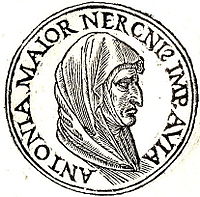Antonia the Elder
| Antonia the Elder | |
|---|---|
 Bust believed to be Antonia Major | |
| Born | August/September 39 BC Athens, Greece |
| Spouse | Lucius Domitius Ahenobarbus |
| Issue | Domitia Lucius Domitius Ahenobarbus Domitia Lepida Major Gnaeus Domitius Ahenobarbus Domitia Lepida Minor |
| House | Julio-Claudian dynasty |
| Father | Mark Antony |
| Mother | Octavia Minor |
| Roman imperial dynasties | ||
|---|---|---|
| Julio-Claudian dynasty | ||
| Chronology | ||
|
27 BC – AD 14 |
||
|
AD 14–37 |
||
|
AD 37–41 |
||
|
AD 41–54 |
||
|
AD 54–68 |
||
|

Antonia the Elder[a] (born August/September 39 BC) was a niece of the first Roman emperor Augustus, being the eldest daughter of Octavia the Younger and her second husband the Triumvir Mark Antony. She married Lucius Domitius Ahenobarbus and became the maternal grandmother of empress Messalina as well as paternal grandmother of the emperor Nero.
Biography[]
Antonia was born in Athens, Greece and after 36 BC her mother, along with her siblings and herself were brought to Rome. She was raised by her mother, her uncle and her aunt Livia Drusilla. According to Cassius Dio after her father died, Augustus allowed her and her younger sister Antonia Minor to benefit from their father's estate in Rome. Although little is known of her, Antonia was held in high regard like her sister Antonia Minor, the mother of the emperor Claudius, who was celebrated for her beauty and virtue.
Issue[]
Around 22 BC Antonia married the consul Lucius Domitius Ahenobarbus. Three of their children are known for certain:
- Domitia the Elder - ancient sources refer to her as Domitia. She married the consul Decimus Haterius Agrippa and bore him a son Quintus Haterius Antoninus. Domitia later married Gaius Sallustius Crispus Passienus, consul suffect in 27, proconsul of Asia and consul in AD 44.
- Gnaeus Domitius Ahenobarbus (PIR2 D127) - consul in AD 32, he married his cousin Germanicus' daughter Agrippina the Younger in 28. Agrippina and Domitius were the parents of the emperor Nero. He was accused by Tiberius, but saved by that emperor's death (Suet. Nero 5) and lived a few years longer under Caligula's reign until he died in AD 40.
- Domitia Lepida (PIR2 D180) - she first married her cousin, the consul Marcus Valerius Messalla Barbatus to whom she bore a daughter, the empress Valeria Messalina, third wife of the emperor Claudius. After the death of her first husband, she married Faustus Cornelius Sulla Lucullus, suffect consul in AD 31, and gave him a son, Faustus Cornelius Sulla Felix (who would become consul in AD 52). At the beginning of Claudius' reign, she married Appius Junius Silanus, consul in AD 28, who was put to death in AD 42. She outlived her daughter, Messalina.
It is also likely that they had another son named Lucius Domitius Ahenobarbus (born between 20 and 17 BC), and possibly also a third daughter (born around 23 BC).[2][3] Syme thinks its possible that the sister may have lived to marry and produce children, but probably died before the reign of Caligula.[4]
Cultural depictions[]
Many scholars think the Ara Pacis (an altar from the Augustan Era), displays Gnaeus Domitius Ahenobarbus and his elder sister. The woman behind Domitia and Domitius is allegedly their mother Antonia Major and the man next to Antonia Major is her husband Lucius Domitius Ahenobarbus. Ronald Syme has argued the two children are actually the elder son Lucius and another unknown sister.[5][6]
Notes[]
References[]
- ^ PIR2 A 884.
- ^ Syme, Ronald (1989). The Augustan Aristocracy (illustrated and revised ed.). Clarendon Press. pp. 155–156. ISBN 9780198147312.
- ^ Syme, Ronald (1989). The Augustan Aristocracy (illustrated and revised ed.). Clarendon Press. p. 167. ISBN 9780198147312.
- ^ Syme, Ronald (1989). The Augustan Aristocracy (illustrated and revised ed.). Clarendon Press. p. 164. ISBN 9780198147312.
- ^ Syme, Ronald (1989). The Augustan Aristocracy (illustrated and revised ed.). Clarendon Press. p. 166. ISBN 9780198147312.
- ^ Pollini, John (1987). The Portraiture of Gaius and Lucius Caesar. Fordham University Press. p. 26. ISBN 9780823211272.
Sources[]
- E. Groag, A. Stein, L. Petersen - e.a. (edd.), Prosopographia Imperii Romani saeculi I, II et III, Berlin, 1933 - . (PIR2)
External links[]
| Wikimedia Commons has media related to Antonia Major. |
- Julio-Claudian dynasty
- 39 BC births
- 1st-century deaths
- 1st-century BC Roman women
- 1st-century Roman women
- Antonii
- Children of Mark Antony